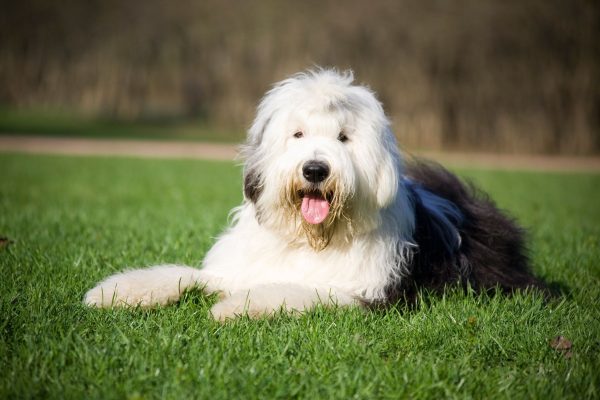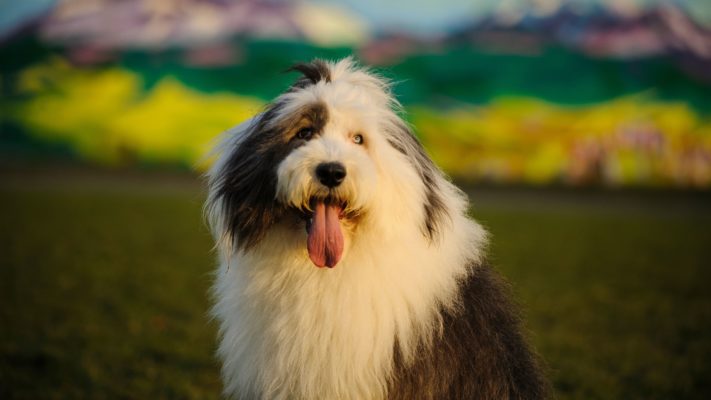Old English Sheepdog (Bobtail)

The Bobtail is a calm, affectionate breed. It is very rarely seen aggressive or nervous. They tend to get along well with children. Puppies are noisy, mischievous, and very clumsy. It takes consistent and careful training to turn them into good fosters.
Table of Contents
Breed Information
| Another Name | Bob-tail or Bobtail |
| Origin | England |
| Height | Males from 54 cm Females from 52 cm |
| Weight | Depending on gender: from 27 to 45 kg |
| Fur | Lush, coarse, wavy, with a good undercoat |
| Color | Gray-blue, white in bluish-marbled tones, sometimes with white markings |
| Lifespan | 10-12 years |
| FCI Classification | Sheepdogs and Cattledogs (except Swiss Cattledogs) |
| Group | Dogs for children, ornamental dogs, sled dogs |
| Price | From $100 |
Breed Photos
Origin History
The Old English Sheepdog, also known as the Bobtail, is a large and athletic dog breed. The sheepdog was bred to herd cattle and help farmers drive cattle and sheep to market.
The Bobtail has one of the most obscure origins in the world. According to one version, the breed originated in the southwestern counties of England sometime in the early 19th century. But according to another version, it may owe its origin to the Scottish bearded collie or the South Russian sheepdog.
Appearance
The Bobtail’s fur is wavy and tangled. The dense undercoat provides considerable protection against weather conditions – it is almost waterproof and hot. The coat’s color varies from shades of gray to blue, with white markings predominating around the head and lower body.
The head is relatively round and reasonably comprehensive. The ears are small and lie close to the skull. They are usually hidden behind the fur.
The body is compact with a wide belly. The back and neck are also broad and muscular, as are the limbs. The small feet are rounded with well convex toes.
Males are 61-65 cm tall and weigh 32-45 kg. At the same time, females are usually 56-62 cm tall and weigh 27-36 kg.
Character
The Bobtail is a calm, affectionate breed. It is very rarely seen aggressive or nervous. They tend to get along well with children. Puppies are noisy, mischievous, and very clumsy. It takes consistent and careful training to turn them into good fosters.
Many owners describe their bobtails as hilarious dogs who take great pleasure in chewing on their owner’s slippers. However, most are very happy with enough training to spend time indoors in close contact with people. Even so, they need regular access to the outdoors to “blow off steam” several times a day. If a breed is deprived of sufficient contact and affection, it thinks it has been separated from its owner. Such a dog is not suitable for outdoor living, nor should it be left without company for most of the day.
Care
Older English sheepdogs require several hours of grooming each week to prevent the coat from sticking together. If layers form, they must be shaved off. They tend to stick quite tightly to the skin, trapping dirt, and their number increases rapidly. The area under the tail requires special care. Hair in this area often traps fecal material, so it must be trimmed and washed regularly. It will require professional grooming at least six times a week.
Other elements in a bobtail’s routine care include monthly claw trimming. Brushing at least four times a week and cleaning the ears to avoid external otitis media should also be observed. Get your dog used to these procedures from a young age. This will make him more obedient, mature, and less stressful – for both dog and owner.
Training
The Bobtail is an intelligent breed that is capable of brilliant training. Introducing puppies to basic obedience skills at 8 to 10 weeks of age will lay the foundation for future good behavior. Home training of an Old English Shepherd puppy is generally not difficult. Cage training should be avoided, as they don’t like to be confined.
Most Old English Sheepdogs enjoy participating in agility lessons or performing tricks. Because of their high energy level, the breed shows an improved ability to concentrate. Without sufficient physical and mental stimulation, they may become bored or grow uncoachable. If this is the case, they will rarely respond to their owner.
Common Diseases
Although the Bobtail level of health problems is relatively low, there are certain risks in the functioning of the nervous system, joints, eyes, and circulatory system. An owner of a Bobtail may encounter these diagnoses of his pet:
- Addison’s disease;
- behavioral disorders;
- cerebellar ataxia;
- demodicosis;
- distichiasis;
- entropy;
- adenitis;
- hemolytic anemia;
- cervical spinal malformation;
- hip dysplasia;
- microphthalmia;
- external otitis media;
- progressive retinal atrophy;
- silica urolithiasis;
- decreased platelet function.
Nutrition
The recommended daily food intake is 2.5 to 4.5 cups of high-quality dry food per day. However, how much an adult dog eats depends on its size, age, build, metabolism, and activity level. Dogs are as individual as people, and they don’t need the same amount of food. A highly active dog will need more than a passive dog.


